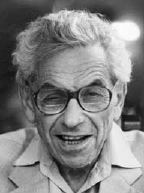

Despite the restrictions on Jews entering universities in Hungary in 1930, Paul Erdös won a national examination and was allowed to enter the University Pázmány Péter in Budapest. Awarded a doctorate there in 1934, he took up a post-doctoral fellowship at Manchester, meeting Hardy and Ulam.
The situation in Hungary by the late 1930's clearly made it impossible for someone of Jewish origins to return. He took a fellowship at Princeton, but Erdös did not conform to
Princeton's standards so he was invited to visit Madison by Ulam.
The contributions which Erdös made to mathematics were numerous and broad. Basically he was a solver of problems, not a builder of theories.
The problems which attracted him most were problems in combinatorics, graph theory, and number theory. He did not just want to solve problems, however,
he wanted to solve them in an elegant and elementary way. To Erdös the proof had to provide insight into why the result was true, not just provide a
complicated sequence of steps which would constitute a formal proof yet somehow fail to provide any understanding.
Some results with which Erdös is most closely associated had been first proved before he was born. Chebyshev proved Bertrand's conjecture in 1850, but when Erdös was only 18 he found an elegant elementary proof of this result. Hadamard and de la Vallée Poussin independently proved the Prime Number Theorem in 1896 using complex analysis. In 1949 Erdös and Selberg found an elementary proof.
Ulam left Madison in 1943 to join other mathematicians and physicists at Los Alamos in New Mexico working on the atomic bomb project.
Erdös went to Purdue University, taking a part-time appointment. After World War II was over, he travelled frequently between England and the United States before accepting a temporary post at the University of Notre Dame in 1952. It was an inspired
offer which gave Erdös complete freedom to rush off to do some joint research whenever he wanted.
During the early 1950's senator McCarthy whipped up strong feelings against communism in the United States. Erdös began to come under suspicion from authorities who saw imaginary problems everywhere. In 1954, after attending a conference in Amsterdam, Erdös was not allowed back to the United States. He spent much of the next 10 years in Israel.
During the early 1960's he made numerous requests to be allowed to return to the United States and a visa was finally granted in November 1963. By this time, however, Erdös had become a traveller moving from one university to another, and from the home of one mathematician to another. However, he did have a home of sorts with his friend Ronald Graham.
Erdös won many prizes, including the Wolf Prize of $50,000 in 1983. However he had a lifestyle that needed little money and he gave most of it away, donating it to help students or as prizes for solving problems he had posed. He wrote over 1500 papers during his lifetime, making him the twentieth century's most prolific mathematician. In fact, many mathematicians measure their distance from Erdös in the collaboration graph and call it their Erdös number.